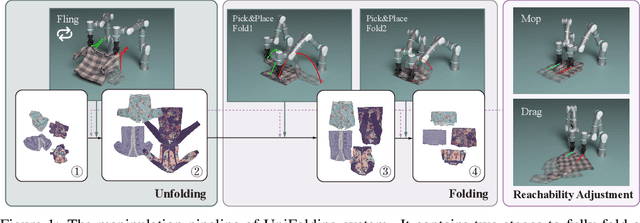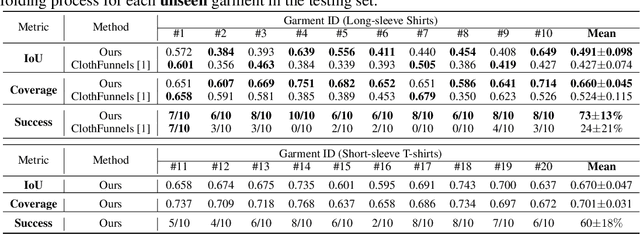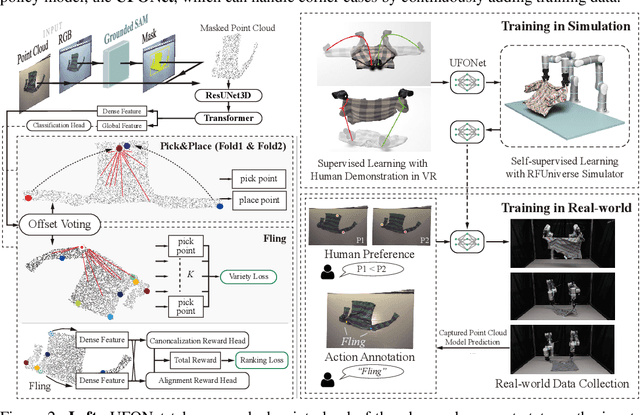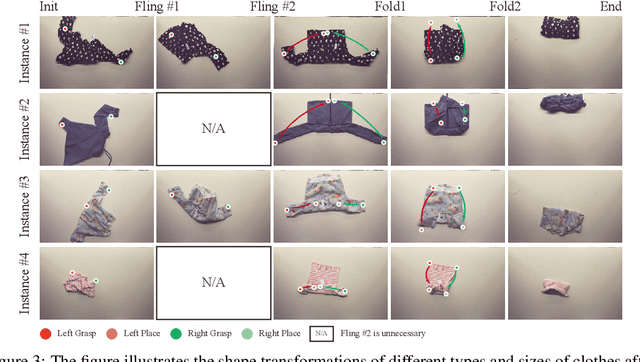Cewu Lu
Precise Robotic Needle-Threading with Tactile Perception and Reinforcement Learning
Nov 04, 2023Abstract:This work presents a novel tactile perception-based method, named T-NT, for performing the needle-threading task, an application of deformable linear object (DLO) manipulation. This task is divided into two main stages: Tail-end Finding and Tail-end Insertion. In the first stage, the agent traces the contour of the thread twice using vision-based tactile sensors mounted on the gripper fingers. The two-run tracing is to locate the tail-end of the thread. In the second stage, it employs a tactile-guided reinforcement learning (RL) model to drive the robot to insert the thread into the target needle eyelet. The RL model is trained in a Unity-based simulated environment. The simulation environment supports tactile rendering which can produce realistic tactile images and thread modeling. During insertion, the position of the poke point and the center of the eyelet are obtained through a pre-trained segmentation model, Grounded-SAM, which predicts the masks for both the needle eye and thread imprints. These positions are then fed into the reinforcement learning model, aiding in a smoother transition to real-world applications. Extensive experiments on real robots are conducted to demonstrate the efficacy of our method. More experiments and videos can be found in the supplementary materials and on the website: https://sites.google.com/view/tac-needlethreading.
UniFolding: Towards Sample-efficient, Scalable, and Generalizable Robotic Garment Folding
Nov 02, 2023



Abstract:This paper explores the development of UniFolding, a sample-efficient, scalable, and generalizable robotic system for unfolding and folding various garments. UniFolding employs the proposed UFONet neural network to integrate unfolding and folding decisions into a single policy model that is adaptable to different garment types and states. The design of UniFolding is based on a garment's partial point cloud, which aids in generalization and reduces sensitivity to variations in texture and shape. The training pipeline prioritizes low-cost, sample-efficient data collection. Training data is collected via a human-centric process with offline and online stages. The offline stage involves human unfolding and folding actions via Virtual Reality, while the online stage utilizes human-in-the-loop learning to fine-tune the model in a real-world setting. The system is tested on two garment types: long-sleeve and short-sleeve shirts. Performance is evaluated on 20 shirts with significant variations in textures, shapes, and materials. More experiments and videos can be found in the supplementary materials and on the website: https://unifolding.robotflow.ai
Open X-Embodiment: Robotic Learning Datasets and RT-X Models
Oct 17, 2023



Abstract:Large, high-capacity models trained on diverse datasets have shown remarkable successes on efficiently tackling downstream applications. In domains from NLP to Computer Vision, this has led to a consolidation of pretrained models, with general pretrained backbones serving as a starting point for many applications. Can such a consolidation happen in robotics? Conventionally, robotic learning methods train a separate model for every application, every robot, and even every environment. Can we instead train generalist X-robot policy that can be adapted efficiently to new robots, tasks, and environments? In this paper, we provide datasets in standardized data formats and models to make it possible to explore this possibility in the context of robotic manipulation, alongside experimental results that provide an example of effective X-robot policies. We assemble a dataset from 22 different robots collected through a collaboration between 21 institutions, demonstrating 527 skills (160266 tasks). We show that a high-capacity model trained on this data, which we call RT-X, exhibits positive transfer and improves the capabilities of multiple robots by leveraging experience from other platforms. More details can be found on the project website $\href{https://robotics-transformer-x.github.io}{\text{robotics-transformer-x.github.io}}$.
Bridging the Gap between Human Motion and Action Semantics via Kinematic Phrases
Oct 11, 2023



Abstract:The goal of motion understanding is to establish a reliable mapping between motion and action semantics, while it is a challenging many-to-many problem. An abstract action semantic (i.e., walk forwards) could be conveyed by perceptually diverse motions (walk with arms up or swinging), while a motion could carry different semantics w.r.t. its context and intention. This makes an elegant mapping between them difficult. Previous attempts adopted direct-mapping paradigms with limited reliability. Also, current automatic metrics fail to provide reliable assessments of the consistency between motions and action semantics. We identify the source of these problems as the significant gap between the two modalities. To alleviate this gap, we propose Kinematic Phrases (KP) that take the objective kinematic facts of human motion with proper abstraction, interpretability, and generality characteristics. Based on KP as a mediator, we can unify a motion knowledge base and build a motion understanding system. Meanwhile, KP can be automatically converted from motions and to text descriptions with no subjective bias, inspiring Kinematic Prompt Generation (KPG) as a novel automatic motion generation benchmark. In extensive experiments, our approach shows superiority over other methods. Our code and data would be made publicly available at https://foruck.github.io/KP.
GAMMA: Generalizable Articulation Modeling and Manipulation for Articulated Objects
Oct 04, 2023Abstract:Articulated objects like cabinets and doors are widespread in daily life. However, directly manipulating 3D articulated objects is challenging because they have diverse geometrical shapes, semantic categories, and kinetic constraints. Prior works mostly focused on recognizing and manipulating articulated objects with specific joint types. They can either estimate the joint parameters or distinguish suitable grasp poses to facilitate trajectory planning. Although these approaches have succeeded in certain types of articulated objects, they lack generalizability to unseen objects, which significantly impedes their application in broader scenarios. In this paper, we propose a novel framework of Generalizable Articulation Modeling and Manipulating for Articulated Objects (GAMMA), which learns both articulation modeling and grasp pose affordance from diverse articulated objects with different categories. In addition, GAMMA adopts adaptive manipulation to iteratively reduce the modeling errors and enhance manipulation performance. We train GAMMA with the PartNet-Mobility dataset and evaluate with comprehensive experiments in SAPIEN simulation and real-world Franka robot. Results show that GAMMA significantly outperforms SOTA articulation modeling and manipulation algorithms in unseen and cross-category articulated objects. We will open-source all codes and datasets in both simulation and real robots for reproduction in the final version. Images and videos are published on the project website at: http://sites.google.com/view/gamma-articulation
Low-Cost Exoskeletons for Learning Whole-Arm Manipulation in the Wild
Sep 26, 2023



Abstract:While humans can use parts of their arms other than the hands for manipulations like gathering and supporting, whether robots can effectively learn and perform the same type of operations remains relatively unexplored. As these manipulations require joint-level control to regulate the complete poses of the robots, we develop AirExo, a low-cost, adaptable, and portable dual-arm exoskeleton, for teleoperation and demonstration collection. As collecting teleoperated data is expensive and time-consuming, we further leverage AirExo to collect cheap in-the-wild demonstrations at scale. Under our in-the-wild learning framework, we show that with only 3 minutes of the teleoperated demonstrations, augmented by diverse and extensive in-the-wild data collected by AirExo, robots can learn a policy that is comparable to or even better than one learned from teleoperated demonstrations lasting over 20 minutes. Experiments demonstrate that our approach enables the model to learn a more general and robust policy across the various stages of the task, enhancing the success rates in task completion even with the presence of disturbances. Project website: https://airexo.github.io/
EgoPCA: A New Framework for Egocentric Hand-Object Interaction Understanding
Sep 05, 2023



Abstract:With the surge in attention to Egocentric Hand-Object Interaction (Ego-HOI), large-scale datasets such as Ego4D and EPIC-KITCHENS have been proposed. However, most current research is built on resources derived from third-person video action recognition. This inherent domain gap between first- and third-person action videos, which have not been adequately addressed before, makes current Ego-HOI suboptimal. This paper rethinks and proposes a new framework as an infrastructure to advance Ego-HOI recognition by Probing, Curation and Adaption (EgoPCA). We contribute comprehensive pre-train sets, balanced test sets and a new baseline, which are complete with a training-finetuning strategy. With our new framework, we not only achieve state-of-the-art performance on Ego-HOI benchmarks but also build several new and effective mechanisms and settings to advance further research. We believe our data and the findings will pave a new way for Ego-HOI understanding. Code and data are available at https://mvig-rhos.com/ego_pca
Flexible Handover with Real-Time Robust Dynamic Grasp Trajectory Generation
Aug 29, 2023



Abstract:In recent years, there has been a significant effort dedicated to developing efficient, robust, and general human-to-robot handover systems. However, the area of flexible handover in the context of complex and continuous objects' motion remains relatively unexplored. In this work, we propose an approach for effective and robust flexible handover, which enables the robot to grasp moving objects with flexible motion trajectories with a high success rate. The key innovation of our approach is the generation of real-time robust grasp trajectories. We also design a future grasp prediction algorithm to enhance the system's adaptability to dynamic handover scenes. We conduct one-motion handover experiments and motion-continuous handover experiments on our novel benchmark that includes 31 diverse household objects. The system we have developed allows users to move and rotate objects in their hands within a relatively large range. The success rate of the robot grasping such moving objects is 78.15% over the entire household object benchmark.
CHORD: Category-level Hand-held Object Reconstruction via Shape Deformation
Aug 21, 2023



Abstract:In daily life, humans utilize hands to manipulate objects. Modeling the shape of objects that are manipulated by the hand is essential for AI to comprehend daily tasks and to learn manipulation skills. However, previous approaches have encountered difficulties in reconstructing the precise shapes of hand-held objects, primarily owing to a deficiency in prior shape knowledge and inadequate data for training. As illustrated, given a particular type of tool, such as a mug, despite its infinite variations in shape and appearance, humans have a limited number of 'effective' modes and poses for its manipulation. This can be attributed to the fact that humans have mastered the shape prior of the 'mug' category, and can quickly establish the corresponding relations between different mug instances and the prior, such as where the rim and handle are located. In light of this, we propose a new method, CHORD, for Category-level Hand-held Object Reconstruction via shape Deformation. CHORD deforms a categorical shape prior for reconstructing the intra-class objects. To ensure accurate reconstruction, we empower CHORD with three types of awareness: appearance, shape, and interacting pose. In addition, we have constructed a new dataset, COMIC, of category-level hand-object interaction. COMIC contains a rich array of object instances, materials, hand interactions, and viewing directions. Extensive evaluation shows that CHORD outperforms state-of-the-art approaches in both quantitative and qualitative measures. Code, model, and datasets are available at https://kailinli.github.io/CHORD.
ClothesNet: An Information-Rich 3D Garment Model Repository with Simulated Clothes Environment
Aug 19, 2023



Abstract:We present ClothesNet: a large-scale dataset of 3D clothes objects with information-rich annotations. Our dataset consists of around 4400 models covering 11 categories annotated with clothes features, boundary lines, and keypoints. ClothesNet can be used to facilitate a variety of computer vision and robot interaction tasks. Using our dataset, we establish benchmark tasks for clothes perception, including classification, boundary line segmentation, and keypoint detection, and develop simulated clothes environments for robotic interaction tasks, including rearranging, folding, hanging, and dressing. We also demonstrate the efficacy of our ClothesNet in real-world experiments. Supplemental materials and dataset are available on our project webpage.
 Add to Chrome
Add to Chrome Add to Firefox
Add to Firefox Add to Edge
Add to Edge